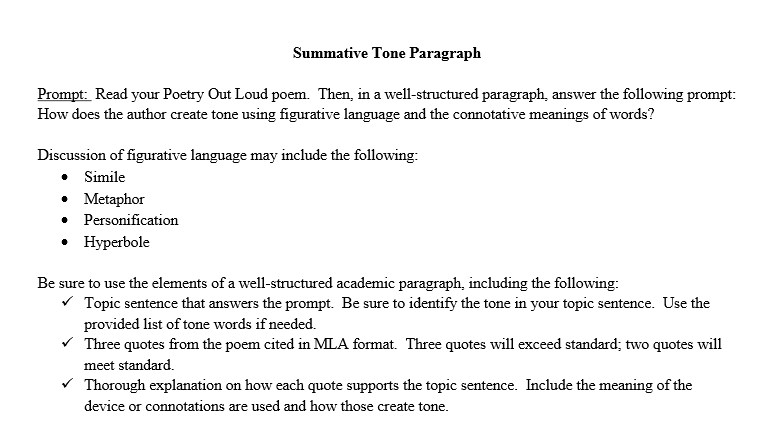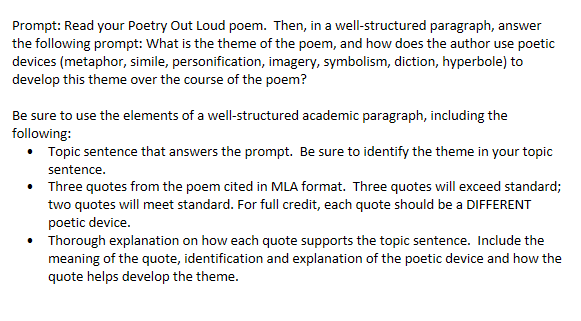They then read their poem aloud to their small groups and share their thoughts. As a group, they write a definition of poetry based off what they explored and send that on to me. I put all the groups' definitions into one document and send that out for students the next day.
We start on the first day by working on basic poetry terms: line, stanza, etc.
The end goal of this unit is to have student compete in a Poetry Out Loud style classroom competition. On the second day of the unit, student select a poem from the POL website that they will work with for the remainder of the unit. Here is a link to that website: http://www.poetryoutloud.org/.
The next day we review the following terms: diction, denotation and connotation. We review the diction in a poem together and then students look at the diction in the POL poem they selected. They use the "New Comment" function under the "Review" ribbon in Word to add comments on the diction in their poems.
They make comments that define unfamiliar terms and identify significant phrases and words in their poems. They also add commentary on the impact the word choice has on the poem's meaning. I always start with an example from a poem I am analyzing:
The next day we review the following terms: analogy, metaphor, simile and personification. We look at poems/examples together and then I model how to identify these devices within my example poem:
This year I gave a quiz the day after this instruction to see what the students had retained and to reinforce the learning.
Finally, students are asked to identify analogies in their own POL poem. They need to identify any analogies present, explain what is being compared and analyze the meaning (in the context of the poem) of the analogy.
In order to get students ready for the POL presentation, I have a few mini-presentations along the way to help. They do research on background associated with their poem/poet and do a short (1 minute-ish) presentation about this. Here are the instructions provided for this:
Directions:
To better understand your poem, you will conduct background research on
the poem and poet of your selected piece. Take all of your notes on this
OneNote page. You will then give a short
1ish minute speech to the class sharing your findings.
Areas of research:
Time period of when the poem was written-any major events
Background information on the poet-reputation, history,
influences, popular works
Research any themes/events referenced within the poem itself.
Background information on the poem itself: when was it
written? Dedicated to/why it was written? Etc…
We do one day of research and then one day of presentations.
Next, we review the term imagery. We look at a couple of poems together and then students create a powerpoint with their POL poem typed on it and images associated with the poem in the background. They are expected to edit the text to highlight significant diction as well. We spend two days in class on this and then a day presenting them. Again, students are getting closer and closer to memorizing and presenting these poems in a classroom competition and each of these mini-presentations is designed to help them become more comfortable with presenting in front of their peers.
Here are a couple of example slides from mine:
Side note: this is one of my favorite assignments from this unit and the students really seem to like it as well.
The next day we review the terms hyperbole and symbolism. We look over poems together and analyze the presence of these devices and then students identify these devices within their POL poem.
Next: tone/mood. We define tone/mood and then we do a tone mapping activity. We do one stanza together as a model and then the students apply this activity to their POL poems. Here is an example of a tone map:
I also have students identify the diction in each line that specifically contributes to the tone they identify. Here is an example of a tone map we did as a class with the significant diction identified:
Here is an example of the comments that students add on to their POL poems for tone/mood:
Finally, the students do a general interactive reading. Here is what I ask that they look for:
The students turn in their POL poems with all of their notes and I grade their reading/note-taking. Here is the rubric I use:
Next, we move on to analysis of the poem as a whole. The 9th grade team requires the students to write two in-class writes. One on tone and one on theme.
The day before the write on tone, we CLOSELY reviewed the prompt and I modeled how to write this paragraph using a poem.
Here is the prompt (created by the 9th grade team):
Here are the notes that students took and my model paragraph:
After that, students printed their poems - identified one of the main tones in their poem and worked to select three quotes to use in their paragraph write.
Next, we moved on to the theme paragraph (also a common assessment created by all the 9th grade teachers at our school). Here is the prompt for that:
We spend a day reviewing the prompt, reviewing the concept of theme, and finally I model a paragraph for the write that students are to complete the next day using my poem. Here are my notes on that:
Now that we have assessed reading and writing in regards to their Poetry Out Loud poems, we move on to the hardest part: speaking or recitation. We watch examples of recitation and review the rubrics/contest evaluation criteria closely.
Here is a link with information about these elements of this:
After all of that we start to work on memorizing our poems. I start with a line-by-line strategy. The students sit in a circle across from a partner. They read their first line only to their partner three times. Then the outside rotates. This time they recite their first line and read their second lines three times. They rotate. Then they recite the first and second lines and read the third line three times. It keeps going throughout the whole period. I encourage students to continue with this strategy at home.
The next day we continue to work on memorization. The students stand this time - they face a partner in a long line. They read their poem to their partner (each side) and then one side rotates. They read to their new partners. Rotate. Read. Repeat. I have them read it a different way each time - this is just to keep them interested/engaged. Here is my list:
- whisper it
- shout it (the neighboring classrooms love this)
- read it as slowly as possible
- read it as quickly as possible
- sing/rap it
- mumble it
- read it without moving
- read it with as much wiggling as possible
- read it with mini-gestures
- read it with huge gestures
Next, we work on gestures and tone. I start by having the kids highlight and identify words that they think deserve special emphasis. I also have them identify where they want to integrate gestures. Finally, I have them re-examine their tone maps and identify the tone for the poem and any tone shifts they want to integrate.
The next day, we work on another memorization strategy: writing the poems out. I give them 5 minutes to silently read through their poem as many times as possible. Then they trade poems with a partner and set them upside down on their desks. On a blank sheet of paper they write out their poem word-for-word including punctuation as accurately as possible. They give the written version to their partner. The partner compares the written and original versions and marks any errors on the written version. They give it back.
Next, they read it aloud (taking turns) until they have each read it aloud 3 times. Then they have 5 minutes to silently look over their own poem again. They trade poems, write and correct. I encourage them to take their poems home and try memorization strategies that worked well for them in class.
The next day they read to small groups and assess each other based on the accuracy/presentation rubrics.
Here is a link with access to these (they are created by the Poetry Out Loud foundation). You have to scroll to the bottom where there are "Resources".
http://www.poetryoutloud.org/competition/organizing-a-contest
Then, class competition day: day 1 I score for accuracy, day 2 I score for performance.
We are done - the next unit will be based off some of the learning from this unit. We are moving into Romeo and Juliet and many of the poetic elements taught for this unit apply to that one as well.
The next day, we work on another memorization strategy: writing the poems out. I give them 5 minutes to silently read through their poem as many times as possible. Then they trade poems with a partner and set them upside down on their desks. On a blank sheet of paper they write out their poem word-for-word including punctuation as accurately as possible. They give the written version to their partner. The partner compares the written and original versions and marks any errors on the written version. They give it back.
Next, they read it aloud (taking turns) until they have each read it aloud 3 times. Then they have 5 minutes to silently look over their own poem again. They trade poems, write and correct. I encourage them to take their poems home and try memorization strategies that worked well for them in class.
The next day they read to small groups and assess each other based on the accuracy/presentation rubrics.
Here is a link with access to these (they are created by the Poetry Out Loud foundation). You have to scroll to the bottom where there are "Resources".
http://www.poetryoutloud.org/competition/organizing-a-contest
Then, class competition day: day 1 I score for accuracy, day 2 I score for performance.
We are done - the next unit will be based off some of the learning from this unit. We are moving into Romeo and Juliet and many of the poetic elements taught for this unit apply to that one as well.
















No comments:
Post a Comment